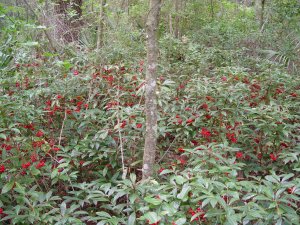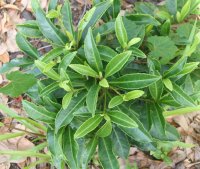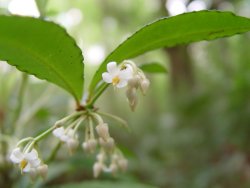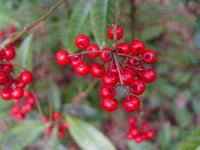Identification and Control of Coral Ardisia (Ardisia crenata) - A Potentially Poisonous Plant
Coral ardisia (Figure 1), also known as coral berry, spice berry, and scratchthroat was introduced into Florida in the early 1900's for ornamental purposes. It has since escaped cultivation and is found in hardwood hammocks, and other moist woods of natural areas and grazing lands. Documented herbarium specimens have been collected from 19 western and south-central Florida counties (Wunderlin and Hansen 2004). It is considered invasive by the Florida Exotic Pest Plant Council and the IFAS Assessment (pdf)(Fox et al. 2005).
Identification
Coral ardisia is an evergreen sub-shrub reaching heights of 1.5 to 6 feet. It tends to grow in multi-stemmed clumps. Leaves (Figure 2) are alternate, 8 inches long, dark green above, waxy, without hairs, scalloped margins and calluses in the margin notches. Flowers (Figure 3) are typically pink to white in stalked axillary clusters, usually drooping below the foliage. The fruit (Figure 4) is a bright red, globose, 1-seeded berry, measuring approximately 0.25 inches in diameter. White-berried populations also exist.
Toxicity
There is no published literature supporting that coral ardisia is toxic. However, there are two cases in Florida where this plant was suspected to be the causal agent for the death of livestock in 2001 and 2007. Berries tend to persist on the plant nearly year-round. It is suspected that the berries and/or foliage are poisonous to livestock, pets, and humans.
Control
Control of coral ardisia can be accomplished by two methods. Low-volume foliar applications of 5% v/v of Garlon 4 or Remedy provides suppression of this plant, but complete foliar coverage is essential. Basal bark applications with an 18% v/v solution of Garlon 4 or Remedy in an oil carrier can also be utilized for suppressing this invasive weed. Do not apply more than 8 quarts of Remedy or Garlon 4 per acre and treat no more than 10% of the total grazed area if applying greater than 2 quarts per acre. Use care when applying high rates of these herbicides when temperatures exceed 90oF as these formulations can volatilize under such conditions. Regardless of application method, retreatment will be necessary for complete control. For more information on basal bark applications, see EDIS publication entitled 'Herbicide application techniques for woody plant control'.
Literature Cited
- Fox, A. M., D. R. Gordon, J. A. Dusky, L. Tyson, and R. K. Stocker. 2005. IFAS Assessment of the Status of Non-native Plants in Florida's Natural Areas. Cited from the Internet (June 8, 2007),http://plants.ifas.ufl.edu/assessment/.
- Wunderlin, R. P., and B. F. Hansen. 2004. Atlas of Florida Vascular Plants. [S. M. Landry and K. N. Campbell (application development), Florida Center for Community Design and Research.] Institute for Systematic Botany, University of South Florida, Tampa.
Figures





